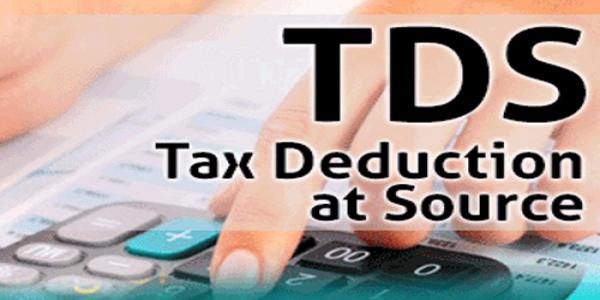What is the latest TDS Rates Chart for FY 2022-23 (AY 2023-24) applicable? Whether there are any changes in rates from the last Financial Year to the current Financial Year?
When we receive income through different ways like Salary, Dividend income from mutual funds or stocks, commission, rent, interest on Bank Fixed Deposits / Securities etc., the providers of this income like Bank or your employer deduct the tax before transferring you such income.
TDS or tax deducted at source is a process of collecting Income Tax at the source. It is a process of deducting the tax from the original source of income.
TDS is calculated and levied on the basis of a certain threshold limit, which is the maximum level of income after which TDS will be deducted from your future income/payments. It is deducted as per the Indian Income Tax Act, 1961.
As I told earlier, apart from salary income and Bank FD earning, there are many ways TDS is deducted like interest income from the post office, insurance commission, rent payment, early EPF withdrawals, the sale of immovable property, rent payments on property etc.,
Basics of TDS (Tax Deducted at Source)
The concept of TDS was introduced with an aim to collect tax from the very source of income. As per this concept, a person (deductor) who is liable to make payment of specified nature to any other person (deductee) shall deduct tax at source and remit the same into the account of the Central Government. The deductee from whose income tax has been deducted at source would be entitled to get a credit of the amount so deducted on the basis of Form 26AS or TDS certificate issued by the deductor.
Let us take an example that you deposited Rs.10,00,000 FD for a year at 8% interest. After a year, you earn an interest of Rs.80,000. Now the bank will deduct TDS on this Rs.80,000 interest at the rate of 10% and deposit the same with Income Tax Department and issue you the TDS certificate which reflects this transaction.
Suppose your income (along with this Bank FD interest of Rs.80,000) is below the basic exemption limit of Rs.2,50,000, then you can file income tax returns and claim the TDS of Rs.8,000 deducted by the Bank and you will get the refund of this.
However, assume that your tax slab is 30%, then you have to pay the remaining 20% tax (30%-10% TDS already deducted) on such interest income of Rs.80,000. Thus you have to pay the tax of Rs.16,000 (Rs.24,000 Total Tax-Rs.8,000 TDS).
Many people to avoid such procedural issues submit the Form 15G/H and think that they avoided the tax. By submitting Form 15G/H, one can avoid the TDS. But one can’t escape from the tax liability.
Latest TDS Rates Chart for FY 2022-23 (AY 2023-24)
In Budget 2022, major changes have been proposed namely related to TDS on payment for the transfer of a virtual digital asset, TDS on Sale of Immovable Property (Higher of Stamp Duty Valuation and Sales Consideration), Higher TDS Rates for Non-Filers of ITR (Reduced Period of 1 year) and TDS on benefit or perquisite of a business or profession.
Considering all these changes, let us now look into the applicable latest TDS Rates Chart for FY 2022-23 (AY 2023-24).
| Section | For Payment of | Threshold limit | TDS Rate % |
|---|---|---|---|
| 192 | Salary Income | Income Tax Slab | Slab rates (Based on old or new tax regimes) |
| 192 A | EPF – Premature withdrawal | Rs 50,000 | 10% If no Pan, TDS @ 30% |
| 193 | Interest on Securites | Rs. 10,000 | 10% |
| 193 | Interest on Debentures | Rs 5,000 | 10% |
| 194 | Dividend (Dividend other than listed companies) |
Rs 5,000 | 10% (No TDS on Div Payouts by REITs / InvITs) |
| 194 A | Interest other than on securities by banks / post office | Rs. 40,000 (Rs 50,000 for Senior Citzens) |
10% |
| 194 A | Interest other than on securities by others | Rs. 5,000 | 10% |
| 194 B | Winnings from Lotteries / Puzzle / Game | Rs. 10,000 | 30% |
| 194 BB | Winnings from Horse Race | Rs. 10,000 | 30% |
| 194 D | Payment of Insurance Commission (Form 15G/H can be submitted) |
Rs. 15,000 | 5% (Individuals) 10% (Companies) |
| 194DA | Payment in respect of Life Insurance Policy | Rs 1,00,000 | 5% |
| 194E | Payment to non-resident sportsmen/sports association | – | 20% |
| 194 EE | Payment of NSS Deposits | Rs 2,500 | 10% |
| 194 G | Commission on Sale of Lottery tickets | Rs 15,000 | 5% |
| 194 H | Commission or Brokerage | Rs 15,000 | 5% |
| 194 I | Rent of Land, Building or Furniture | Rs. 2,40,000 | 10% |
| 194I | Rent of Plant & Machinery | Rs. 2,40,000 | 2% |
| 194 IB | Rent (Tenant has to deduct TDS) (Individuals who are not liable to Tax Audit) |
Rs 50,000 (per month) | 5% |
| 194 IA | Transfer of Immovable Property , other than Agricultural land | Rs. 50 lakh | 1% |
| 194IC | Payment of monetary consideration under Joint Development Agreements | – | 10% |
| 194J | Fees for professional or technical services | Rs 30,000 | 2% (or) 10% |
| 194LA | Payment of compensation on acquisition of certain immovable property | Rs 2,50,000 | 10% |
| 194 LB | Interest from Infrastructure Bond to NRI | NA | 5% |
| 194 LD | Interest on certain bonds and govt. Securities | NA | 5% |
| 194N | Cash withdrawal during the previous year from one or more account maintained by a person with a banking company, co-operative society engaged in business of banking or a post office: | > Rs 1cr | 2% |
| 194Q | Purchase of goods (applicable w.e.f 01.07.2021) | Rs 50 lakh | 0.10% |
| 206AB | TDS on non-filers of ITR at higher rates (applicable w.e.f 01.07.2021) |
– | Higher of – 5% – Twice the rate in act – Twice the rate or rate in force |
| 194P | TDS on Senior Citizen above 75 Years (No ITR filing cases) | – | Slab Rates |
| 206AA | TDS rate in case of Non availability of PAN |
– | Higher of – As per act Twice the rate or rate in force 20% |
| 194S | TDS on payment for Virtual Digital Assets |
– | 1% |
Many of you may be aware that the new section 194S was introduced during Budget 2022. Let me share some inputs on this.
In order to widen the tax base from transactions so carried out in relation to the Virtual Digital Assets, it is proposed:-
to insert section 194S to the Act to provide for deduction of tax on payment for transfer of virtual digital asset to a resident at the rate of one per cent of such sum.
Payment in Kind/Exchange
In case the payment for such transfer is–
(i) wholly in kind or in exchange of another virtual digital asset where there is no part in cash; or
(ii) partly in cash and partly in kind but the part in cash is not sufficient to meet the liability of deduction of tax in respect of whole of such transfer, the person before making the payment shall ensure that the tax has been paid in respect of such consideration…Read more>>
Source:-basunivesh




